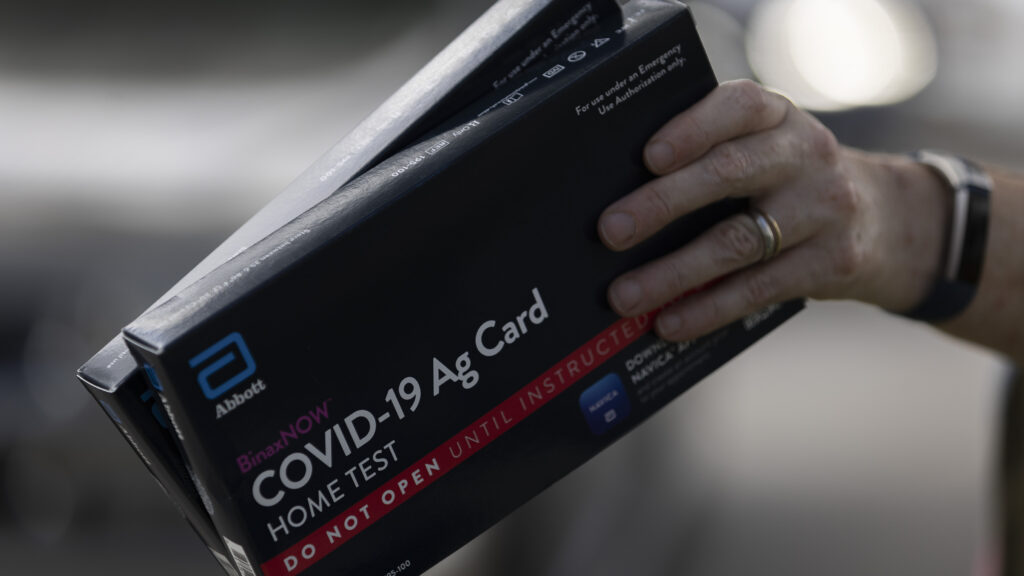A new study raises significant doubts about whether at-home rapid antigen tests can detect the Omicron variant before infected people can transmit the virus to others.
The study looks at 30 people from settings including Broadway theaters and offices in New York and San Francisco where some workers were not only being tested daily but were, because of rules at their workplaces, receiving both the antigen tests and a daily test that used the polymerase chain reaction, or PCR, which is believed to be more reliable.
On days 0 and 1 following a positive PCR test, all of the antigen tests used produced false-negative results, even though in 28 of the 30 cases, levels of virus detected by the PCR test were high enough to infect other people. In four cases, researchers were able to confirm that infected people transmitted the virus to others during the period before they had a positive result on the rapid antigen test.
advertisement ‘I think that with every new variant that comes, scientists have to question whether the things that were previously true are still true,’ said Blythe Adamson, the lead author of the paper and the principal epidemiologist at Infectious Economics in New York. ‘This one has a different way it travels, a different mechanism of action of symptoms, it has different windows of transmission.’ Adamson, who is also an employee of Flatiron Health, a unit of Roche, said that it was also possible there were more cases of transmission than the authors were able to confirm.’It’s absolutely likely there were many more than four transmissions,’ Adamson said. ‘We named four because there were four that were confirmed through contact tracing and epidemiology investigation. There were likely many more.’
advertisement The study included both the Abbott BinaxNOW and Quidel QuickVue rapid antigen tests, both of which are authorized by the Food and Drug Administration.
The results were published in a preprint, meaning they have not yet been reviewed by outside researchers.
A chart from the study shows significant false negatives in the early days after infection. Blythe Adamson/Infectious EconomicsOther data from the group indicate that viral loads peaked in saliva one to two days before they peaked in tests taken from nasal swabs, adding to evidence that swabs taken from the mouth or throat may detect the SARS-CoV-2 that causes Covid better than the nasal swabs used for many PCR and antigen tests.
‘This group of experts who have been doing sequential testing is raising the uncomfortable possibility that antigen testing is missing people that can infect others,’ said Harlan Krumholz, director of the Center for Outcomes Research and Evaluation at Yale. ‘They are using state-of-the-art methods and sound epidemiologic approaches leveraging a well-designed occupational health program.’
While he was not involved in the research, Krumholz is thanked in acknowledgements section of the paper.
Despite its small size, the results in the study are remarkably consistent. Not a single rapid antigen test detected the virus until nearly two days after the initial positive PCR result. Additionally, the cases of infection from people who had received false negative results could raise alarm bells.
However, the researchers emphasize, this does not mean that rapid antigen tests are not useful. The tests also detected the virus in every case – it just took longer than with PCR. So while the tests may not work as an early warning, a positive test result at home does likely mean that the person taking the test has Covid-19. Anne Wyllie, a researcher at the Yale School of Public Health and a co-author on the paper, said that the reports she is seeing from the general public on social media also raise her level of concern.
‘If the general public is seeing this and reporting on it, you know, this is also a lot of evidence for me,’ Wyllie said. ‘Like they’re actually seeing it. This is a lot more widespread than just this one outbreak that we were observing.’
During the pandemic, Adamson and Infectious Economics became consultants to many Broadway productions that were trying to keep their staffs safe from Covid. The risk to audiences was relatively easy to control, but cast and crew members worked in cramped quarters where lots of safety precautions, including vaccination, masking, and the use of rapid tests were all necessary to keep people safe.
She said that as soon as Omicron hit, there were anecdotes about rapid antigen tests remaining negative until days after the infected people had already developed symptoms. She said she started to feel anxiety about whether precautions to keep cast members safe would be enough. Since then, numerous Broadway shows, including ‘Waitress’ and ‘Jagged Little Pill,’ have announced Covid-related closures.
https://www.statnews.com/2022/01/05/study-raises-doubts-about-rapid-covid-tests-reliability-in-early-days-after-infection/
